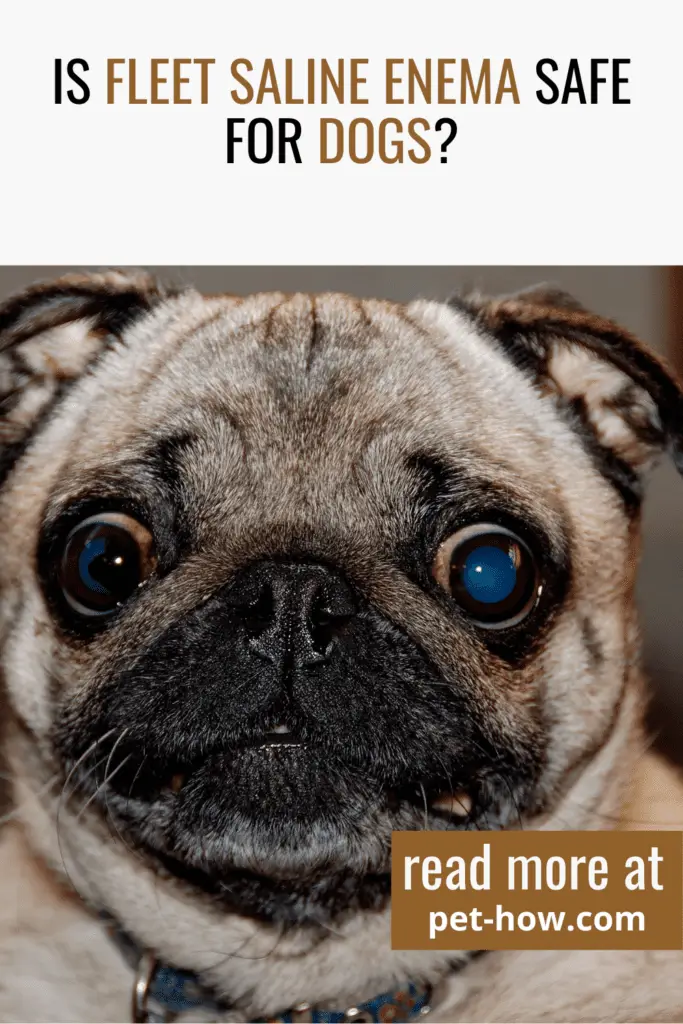Fleet Saline Enema is commonly used in humans to relieve constipation, but it is not recommended for use in dogs without first consulting a veterinarian.
If you want to give your dog a fleet saline enema, read this article first.
Is Fleet Saline Enema Safe For Dogs
What is Fleet Saline Enema?

Fleet Saline Enema is a product that provides relief from occasional constipation, irregularity, and minor bowel cleansing. It is an effective, safe, and gentle way to restore normal bowel function.
The solution contains sodium bicarbonate (a form of salt), which helps to draw water into the colon to soften stools, as well as other ingredients such as sorbitol (sugar).
This combination creates an isotonic solution that helps stimulate the large intestine to eliminate hard stools.
Additionally, Fleet Saline Enema contains potassium phosphate which helps neutralize fecal acidity and reduce irritation in the rectum.
When used as directed, Fleet Saline Enema acts quickly to provide relief from occasional constipation.
The solution works to soften stools and stimulate the muscles of the colon, allowing for easier bowel movements. The product is intended for adults and children 12 years of age and over.
Most pet parents think that products that are safe for human use are also safe for dogs.
However, that is not always the case.
(See also: What To Expect After a Dog Enema (Answered!)
Is Fleet Saline Enema Safe For Dogs
Is Fleet Saline Enema Safe For Dogs?
Fleet Saline Enema is not safe nor recommended for dogs because it contains sodium phosphate and sodium chloride which can cause electrolyte imbalances.
Some of the potential risks associated with using this product in dogs include irritation and inflammation of their gastrointestinal tract, electrolyte imbalances due to excessive sodium intake, and an increased risk of dehydration.
Additionally, Fleet Saline Enema may also interfere with certain medications that are commonly used in veterinary medicine (such as antibiotics), leading to unexpected adverse reactions or even toxicity.
Furthermore, this product should not be given to pregnant or nursing animals since its effects on those conditions have not been fully studied.
When an enema is given, salt and other minerals dissolve into the fluid and become available to be absorbed by the body.
If too much or too little salt is present in the solution, then this can lead to electrolyte imbalances in dogs as their bodies are unable to regulate these levels correctly.
Additionally, if an enema is given too often, a buildup of excess salts can occur which can lead to dehydration or other health issues such as vomiting and diarrhea.
(Related: 7 Side Effects of Giving Dog an Enema)
Is Fleet Saline Enema Safe For Dogs
What Are The Alternative Treatments For Constipation in Dogs?
While constipation is best treated with an enema, taking preventive measures to avoid constipation is also a great idea.
Dietary changes to promote regular bowel movements
The ideal diet for promoting regular bowel movements in dogs will depend on the individual needs of your pet. However, there are some general guidelines to consider when selecting food for your pet:
- Choose a high-fiber diet. Fiber helps to bulk up stool and keeps it from becoming too dry or hard, making it easier for the dog to pass. Look for foods that contain natural sources of fiber such as fresh fruits and vegetables, whole grains, and legumes.
- Select a diet with appropriate amounts of fat and protein as well as carbohydrates. Too much fat can lead to diarrhea, while too much protein can result in constipation in some cases.
- Make sure to include plenty of moisture in your dog’s diet. Dogs require at least 1 ounce of water per pound of body weight each day. Adding canned or wet food to their diets can also help provide the necessary moisture.
- Opt for a balanced and complete diet that meets all of your pet’s nutritional needs. This will keep your pet energized and healthy while ensuring they get all of the vitamins and minerals they need to stay regular.
- Avoid foods with artificial additives, preservatives, or fillers such as corn syrup or wheat gluten, as these can lead to digestive problems including irregular bowel movements.
(See also: What Is a Dog Enema And When Is It Needed)
Increasing water intake and exercise
Water is an important part of the digestive system, as it helps to move food through the intestines and out of the body. Increasing a dog’s water intake is one way to help promote regular bowel movements.
Dogs should be given access to fresh, clean drinking water at all times. If your dog consistently refuses water, try adding some low-sodium chicken broth or tuna juice for flavor.
Exercise also helps support healthy digestion and elimination in dogs. Working their muscles can stimulate contractions within the digestive tract that may help push out waste more effectively.
Taking your pup on regular walks and engaging them in activities such as fetch or agility can help keep their bowels moving regularly.
In addition, being outdoors gives them plenty of opportunity to take in the sights and smells of their environment, which can help them to relax and become more comfortable with their surroundings.
When to consult a veterinarian for constipation
If your dog is exhibiting signs of constipation, such as dry stools, straining to defecate, lack of appetite, or lethargy for a few days, it’s important to consult a veterinarian.
Constipation in dogs can be caused by:
- Dietary imbalance and dehydration
- An obstruction in the intestine due to a foreign object
- A physiological issue such as cancer or spinal cord injury
- May be a symptom of systemic diseases like hypothyroidism
A professional veterinary examination can help identify the underlying cause which requires appropriate treatment for a successful resolution.
Your veterinarian might also suggest making changes to your dog’s diet including adding fiber-rich foods like pumpkin puree or psyllium husks to promote regularity.
In some cases, your vet may prescribe a laxative or stool softener to help move things along. If the underlying cause is an obstruction, surgery may be necessary.
(See more: How To Prepare Your Dog And Perform An Enema)
Is Fleet Saline Enema Safe For Dogs
In Conclusion
While Fleet Saline Enema is not safe for dogs, there are a lot of options for enema.
It is important to reach out to your veterinarian and determine the cause of constipation.
Then, with the help and guidance of the vet, you can safely give your dog an enema.



Leave a Reply